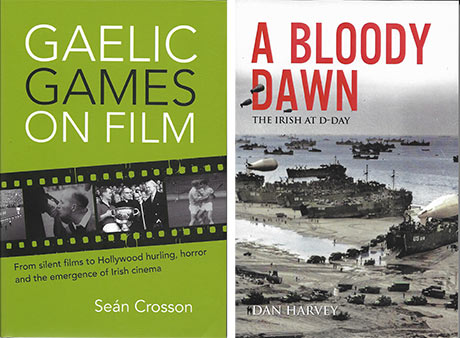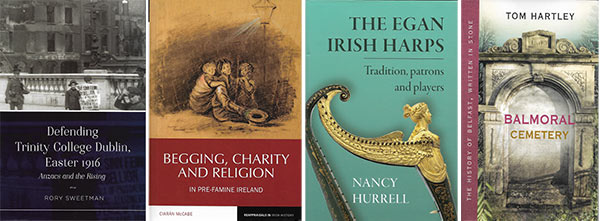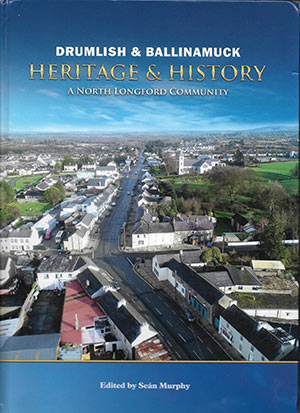BOOKWORM
Published in Book Reviews, Issue 5 (September/October 2019), Volume 27By Joe Culley
@TheRealCulls
In October 1921, in the midst of the Treaty negotiations, a Pathé newsreel shown in Irish cinemas featured (on the intertitle) ‘Commandant McKeon’ wearing his IRA uniform while throwing in the sliotar for a match. This might seem innocuous except that, from the (still) governing British perspective at least, McKeon had no such military status. Clearly, however, the normally apolitical Pathé was already anticipating an independent Irish state.
This little nugget is just one of many that pop up in Seán Crossan’s intriguing Gaelic games on film: from silent films to Hollywood hurling, horror and the emergence of Irish cinema. In his survey Crossan, who lectures on film studies at NUI Galway, takes a chronological approach, from turn-of-the-century newsreels and the silent Knocknagow to the homegrown zombie flick Dead Meat, to examine how and—crucially—why Gaelic games appeared on the big screen. (Their role in TV, though touched on here, is another and different discussion.) The tone and style are, understandably, academic (for instance, each chapter concludes with a summation of the arguments presented in the previous pages) but remain accessible to the general reader. (On Twitter, I described the prose as dry, to which one person responded: ‘You say dry, I say grounded in the academic discourse’. I think we’re both right.)
One of the prime motifs is how the games were used, particularly in foreign productions, to confirm stereotypes. In particular, this often meant the equation: Hurling = Violence = Irish. Even someone as sympathetic to Ireland as John Ford exploited such misconceptions, and he would introduce a hurley into a scene as a harbinger of other, imminent violence. At the same time, American filmmakers, again notably the Johns, Ford and Huston, also used stories set in Ireland to complement and assist the growing assimilation and ascent into respectable society of the American Irish in the mid-twentieth century. And in 1955 a short on hurling, Three Kisses, was nominated for an Oscar.

Our indigenous film industry, such as it was until relatively recently, often used Gaelic sport as ‘… an important cultural resource in affirming Irish identity and … the Irish nation’. A shift occurs in the late 1960s, however, with Rocky Road to Dublin, and by the mid-1980s we have Clash of the Ash, which challenges received ideas of Irish masculinity and identity, and in 2004 the zombie caper Dead Meat, in which ‘the hurley is the new chainsaw’, which offers a different take on rural Ireland. If you don’t mind the odd dip into post-modern theory, you’ll enjoy this. Mind you, it’s a €39 hardback, so maybe order it from your library.
Retired army officer Dan Harvey continues his prolific second career as a battle historian with the fourth in his series on Irish participation in famous engagements, this time A bloody dawn: the Irish at D-Day. Though the story of D-Day is well known, the specific experiences of the Irish involved have not been collated. Harvey gives a nice overview of the events, during which we meet, among a great many others, Dubliner Michael d’Alton, who served on a landing craft and witnessed the carnage at Omaha Beach, and Kathern-Anne McCarthy, a nun from Drimoleague, who had been based in Paris and joined the Resistance. Some are of Irish ancestry, such as Andrew Jackson Higgins of New Orleans, who had designed some of the landing craft.
In Defending Trinity College Dublin, Easter 1916: Anzacs and the Rising, Rory Sweetman challenges the received understanding that the college environs largely escaped the turmoil of Easter week. Instead, he tells the tale of how five New Zealanders, veterans of Gallipoli, served as the core of a small squad of colonial troops that repelled a rebel attempt to take the college at midnight on Easter Monday. Sweetman’s tale is greatly enlivened by the personal letters the ANZAC troops sent home to their families detailing the events.

As part of the ‘Reappraisals in Irish History’ series, Ciarán McCabe has produced Begging, charity and religion in pre-Famine Ireland. It is a dense but often fascinating study which ‘explores at length for the first time the complex cultures of mendicancy, as well as how wider societal perceptions of and responses to begging were framed by social class, gender and religion’. Interestingly, it is available, open access, at the Oapen Library (oapen.org), so log in and judge for yourself.
 In the early nineteenth century the young John Egan reconfigured the ancient Gaelic harp into a smaller instrument capable of producing a tone and range more suited to the contemporary ear. In her exhaustive study, The Egan Irish harps: tradition, patrons and players, Nancy Hurrell brings to light how the Egan harp influenced the music-making of literary celebrities Thomas Moore and Sydney Owenson, and profiles the players, notably Patrick Byrne, ‘the last blind harper’.
In the early nineteenth century the young John Egan reconfigured the ancient Gaelic harp into a smaller instrument capable of producing a tone and range more suited to the contemporary ear. In her exhaustive study, The Egan Irish harps: tradition, patrons and players, Nancy Hurrell brings to light how the Egan harp influenced the music-making of literary celebrities Thomas Moore and Sydney Owenson, and profiles the players, notably Patrick Byrne, ‘the last blind harper’.
A former Sinn Féin lord mayor of Belfast, Tom Hartley, has produced the third in his ‘Written in Stone’ series on the cemeteries of the city, Balmoral cemetery. Also known as Belfast cemetery, Malone, it was traditionally the resting place of the city’s Presbyterian community, so this is in fact a study of the rich history of Presbyterianism in Belfast. (One quibble for the publishers, Blackstaff Press: the extra-light sans typeface, which alternates with a standard face, is difficult to read.)
The local North Longford historical society has produced Drumlish and Ballinamuck, heritage and history. It covers all aspects of the place: the land, the people, and notable events and recollections.
Seán Crossan, Gaelic games on film: from silent films to Hollywood hurling, horror and the emergence of Irish cinema (Cork University Press, €39 hb, 242pp, ISBN 9781782052470).
Dan Harvey, A bloody dawn: the Irish at D-Day (Merrion Press, €14.95 pb, 250pp, ISBN 9781785372414).
Rory Sweetman, Defending Trinity College Dublin, Easter 1916: Anzacs and the Rising (Four Courts Press, €19.95 pb, 188pp, ISBN 9781846827846).
Ciarán McCabe, Begging, charity and religion in pre-Famine Ireland (Liverpool University Press, £29.95 hb, 320pp, ISBN 9781786941572).
Nancy Hurrell, The Egan Irish harps: tradition, patrons and players (Four Courts Press, €45 hb, 302pp, ISBN 9781846827594).
Tom Hartley, Balmoral cemetery (Blackstaff Press, £12.99 pb, 376pp, ISBN 9781780732305).
Seán Murphy (ed.), Drumlish and Ballinamuck, heritage and history (Drumlish Heritage and History Society, €30 hb, 268pp, ISBN 9781789266337).
















